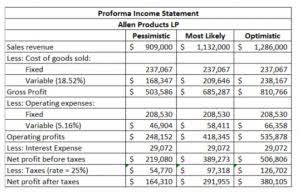Net Working Capital NWC Formula + Calculator

For many firms, the analysis and management of the operating cycle is the key to healthy operations. The three sections of a cash flow statement under the indirect method are as follows. An optimal amount of Net Working Capital brings liquidity to your business.
Ability to Remain Strong during Financial Recession
Thus, you must always ensure that your current assets are in excess of its current liabilities to manage the liquidity position of your firm. This is because current assets help in creating a buffer for meeting your obligations within your ordinary operating cycle. Thus, your short-term creditors always prefer that you maintain current assets higher than your current liabilities. calculating change in working capital To calculate working capital, subtract a company’s current liabilities from its current assets. Both figures can be found in public companies’ publicly disclosed financial statements, though this information may not be readily available for private companies.
The Change in Working Capital – Video Table of Contents:
Understanding changes in cash flow is also important if you are applying for a small business loan. Lenders will often look closely at a potential borrower’s working capital and change in working capital from quarter-to-quarter or year-to-year. • Changes impact a company’s need for external financing for operations or expansion. A company’s growth rate can affect its change in net working capital requirements.
- This increase in working capital will have a negative impact on the company’s cash flow since the cash is now tied up in the business and cannot be used for other purposes.
- But it is important to note that those unmet payment obligations must eventually be settled, or else issues could soon emerge.
- However, income tax departments insist that tax should be paid during the previous year itself on the estimated income to be earned on the principle of pay as you earn.
- If the Change in Working Capital is positive, the company generates extra cash as a result of its growth – like a subscription software company collecting cash for a year-long subscription on day 1.
- When there is an increase in working capital of a company, it means that the company has more cash available to fund its operations.
- Therefore, financial managers must develop effective working capital policies to achieve growth, profitability, and long-term success.
Formula for Calculating Change in Working Capital
- The $500 in Accounts Payable for Company B means that the company owes additional cash payments of $500 in the future, which is worse than collecting $500 upfront for future products/services.
- It’s worth noting that while negative working capital isn’t always bad and can depend on the specific business and its lifecycle stage, prolonged negative working capital can be problematic.
- For example, if a company has $1 million in cash from retained earnings and invests it all at once, it might not have enough current assets to cover its current liabilities.
- Managing your working capital involves liquidity management, accounts receivable management, inventory management, accounts payable management, and short-term debt management.
Current assets are the assets that can be converted into cash within a short period of time, typically one year. Such assets include cash, short-term securities, accounts receivable, and stock. Working capital is a basic accounting formula (current assets minus current liabilities) business owners use to determine their short-term financial health. Changes in working capital can occur when either current assets or current liabilities increase or decrease in value.
How to Reconcile Change in NWC on Cash Flow Statement

This example shall give us a practical outlook of the concept and its ebbs and flows. Learn online from Wall Street Prep — the training firm that prepares new hires at the world’s top financial institutions. This insights and his love for researching SaaS products enables him to provide in-depth, fact-based software reviews to enable software buyers make better decisions. A company that keeps track of the working capital will have a smooth run. Companies with large working capital can finance big projects for expansion. Contact your customers that have bought a large number of goods on credit.
Current Liabilities

Using hedging strategies to offset swings in cash flow can mitigate unexpected changes in working capital. However, there are some costs involved in these hedging transactions, which could affect cash flow. Change in net working capital refers to how a company’s net working capital fluctuates year-over-year. If your net working capital one year was $50,000 and the next year it was $75,000, you would have a positive net working capital change of $25,000. • External financing options include angel investors, small business grants, crowdfunding, and small business loans. Changes in working capital are often used by investors and lenders to assess the health and value of a business.
Working Capital Formula
As can be seen any net movement in inventory, accounts receivable or accounts payable over an accounting period, results in a corresponding net movement in working capital. A statement of changes in working capital is prepared to measure the increase or decrease in the individual items of current assets and current liabilities. It also shows the net increase or decrease in https://www.bookstime.com/ the working capital during the accounting period. In simple terms, working capital is the net difference between a company’s current assets and current liabilities and reflects its liquidity (or the cash on hand under a hypothetical liquidation). In financial accounting, working capital is a specific subset of balance sheet items and is calculated by subtracting current liabilities from current assets.

This is because cash remaining idle would earn https://x.com/BooksTimeInc nothing for your business. Likewise, inadequate investment in current assets could threaten the solvency of your business. For example, consider a manufacturing company facing challenges in collecting receivables from customers, leading to a significant increase in A/R. Meanwhile, the company experiences rapid growth in production, requiring increased inventory levels and faster payments to suppliers, causing a surge in A/P. In this scenario, the company’s net working capital decreases, signaling potential cash flow constraints and liquidity challenges.
Short Operating Cycles

But if current assets don’t exceed current liabilities, the company has negative working capital, and may face difficulties in growth, paying back creditors, or even avoiding bankruptcy. Working capital, often referred to as the lifeblood of a business, represents the funds available for day-to-day operations. It encompasses current assets such as cash, inventory, and accounts receivable, minus current liabilities like accounts payable and short-term debt. Changes in working capital reflect the fluctuations in a company’s short-term assets and liabilities over a specific period. It’s a commonly used measurement to gauge the short-term financial health and efficiency of an organization. You’ll need to tally up all your current assets to calculate net working capital.
